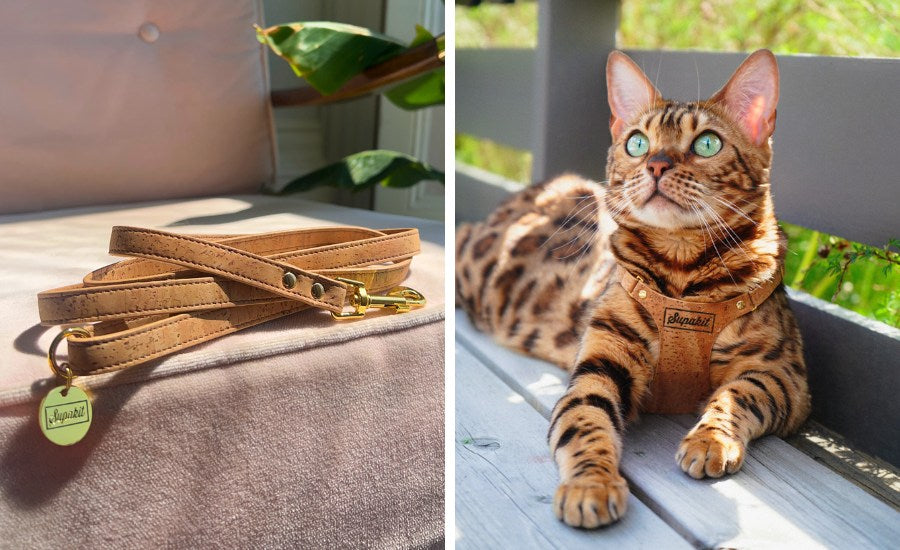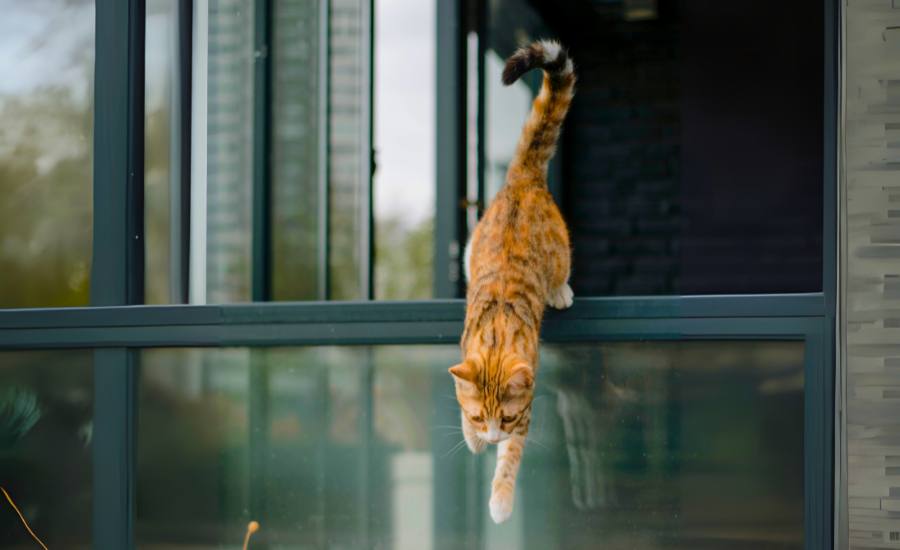Which Cat Tracker Is The Best For Your Cat?
Have you ever thought about buying a cat tracker or cat tracking collar, but found the wide range of options confusing? We hear you! We've spent the past three years looking for the purrfect cat tracker.
Spoiler alert: We haven't found the ideal cat tracker yet, but we have collected a wealth of information that could help you find the best of the bunch for your kitty.
In a nutshell, there are only really three types of cat tracker to choose from:
- Radio frequency cat trackers
- Bluetooth cat trackers
- GPS cat trackers
Each one uses a different type of technology to help locate your cat, which dictates the size, shape and weight of the tracker. Each technology type comes with its own set of strengths and weaknesses. Below you can find our lowdown on how each type shapes up (along with some examples of trackers in each class), so that you can see if there's a cat tracker that will work for your kitty and their style of adventuring!
Radio Frequency Cat Trackers
![]()
Examples of radio frequency cat trackers:
-
Tab Cat
-
Girafus
-
Eureka Marco Polo
The Supakit verdict on radio frequency trackers
Best for long-term wear due to size and battery life. They might not be ideal if you live in a built up area, but in flat open environments the tech performs well.
How do radio frequency cat trackers work?
Radio frequency cat trackers work by giving you two devices. One is a radio transmitter which your cat wears (it uses inaudible radio waves that neither you nor your cat will hear). The other is a receiver handset, which you keep. It measures the strength of your cat's signal to tell you which direction your cat is in and how close to you it is.
By following the signal on your handset, you can close in on your missing kitty and locate them! You won't get a map display, it's more like playing 'hotter / colder' with your kitty. When you get closer the display will light up or beep more, and if you move further away it will go quiet.
Benefits of radio frequency cat trackers
-
Smallest & lightest of all trackers: Radio frequency pet trackers are typically smaller and lighter than other types. This is super important, both for your kitty's comfort but also to enhance the chances of it staying on if attached to a breakaway collar.
-
Good battery life: Radio frequency trackers aren't power hungry, and so can use smaller batteries that last longer, in some cases up to 1 year. (Just watch out though, some don't allow you to change the battery so for those you'd need to buy a new tracker yearly when the batteries run out).
-
Medium initial cost, no monthly fees: Radio frequency trackers are typically priced somewhere between the bluetooth types (cheaper) and GPS types (more expensive). The good news is that they don't require a monthly subscription for cell phone coverage, so you only have to pay once.
- Works in all countries: If you travel with your cat, a radio frequency cat tracker will still work overseas.
Limitations of radio frequency cat trackers
-
Limited range: Radio frequency trackers have a range that typically extends to around 122 metres / 400 feet. This means that if your cat roams further than this, then the device won't be able to help you locate your cat at all (in this case you'll have to use other methods to get back within range of your cat e.g. sightings and then use the device to narrow down their exact location).
-
Reduced range when there are obstacles in the way: Radio waves can be disrupted by objects between you (holding the receiver) and your cat (who has the transmitter). That means that if you're in a built up area where there could be lots of walls between you and your cat, the range of the tracking will be greatly reduced.
- No visual display: These types of trackers don't come with an app or visual display that can show you exactly where your cat is. The tracker will guide you, but you still have to put in the leg work to locate them!
Bluetooth Cat Trackers
![]()
Examples of bluetooth cat trackers:
- Apple AirTag (a popular choice, you may want to check out our range of AirTag holders, made specially for cats!)
- Samsung Smart Tag
- Tile Pro
- Cat Tailer
- Cube Pro
The Supakit verdict on bluetooth trackers
A good all-rounder option, particularly if you live in an densely populated area where there's a big community of 'app network' users to enhance your chances of locating your kitty.
How do bluetooth cat trackers work?
Bluetooth cat trackers work in a similar way to radio frequency trackers. You still get a transmitter to put on your cat (this time it transmits a bluetooth signal). However, instead of a dedicated handset you can simply use your phone as your locating device, because all modern phones have a built-in bluetooth receiver.
Being able to use your phone as a receiver is pretty handy. You typically get a map of your cat's approximate location, which is cool. In addition, many bluetooth trackers come with apps that allow you to connect with other users, so if your cat is in range of any phone in the app network (not just your own) then it will 'ping' your cat's location to your app.
And, of course using a phone saves you from having extra devices to worry about. You can pretty much guarantee that you're going to have your phone with you when you need it!
Benefits of bluetooth cat trackers
-
Small & lightweight: This is a field where the technology is developing fast. We've found that the latest models of bluetooth trackers are reducing in size and weight. They're not quite as petite as the radio trackers (typically) but they are an OK size for most kitties.
-
Visual map display: Bluetooth trackers usually come with apps, so that you can get an easy-to-read map display showing the current location of your cat. Not only is this handy if your cat goes missing, but it's also nice to be able to check in on them without going on a full-blown rescue mission!
-
Extended range thanks to app networks: If you opt for a Bluetooth tracker from one of the more established brands such as the Apple AirTag or Tile, you’ll also have access to their community of Bluetooth users, meaning if your kitty wanders out of Bluetooth range of your own phone but happens to mooch past another AirTag user, their phone will automatically and anonymously pick up their location and update it on your app – handy, right?!
-
Good battery life: Bluetooth cat trackers don't use too much battery, so they tend to have a reasonable battery life for their size.
-
Low initial cost, no monthly fees: Bluetooth trackers are among the lowest cost pet trackers, and they don't require monthly subscriptions.
- Works in all countries: If you travel with your cat, the bluetooth component of your tracker will still work (it talking directly to your phone). You may find however, that there are a lot fewer 'app network' users in other places.
Limitations of bluetooth cat trackers
-
Limited range: The range for many Bluetooth trackers spans from around 46 - 122 metres / 150 - 400 feet, so if your cat were to roam far from home (and your phone!) then the chances of you locating them without the assistance of other community users is slim.
- Reduced range when there are obstacles in the way: You may find that the range of your bluetooth tracker falls short of the range advertised if you're using it in an area with lots of obstacles between you and your cat.
GPS Cat Trackers
![]()
Examples of GPS trackers for cats:
- Tractive
- Pet Tracer
- Pawtrack GPS Collar
- Jiobit
The Supakit verdict on GPS trackers
Best for (very) big cats! Or for short periods in situations where the risk to your cat's welfare if lost would outweigh any mild discomfort that wearing the device may cause them e.g. if travelling and your cat would be in immediate danger if lost.
How do GPS cat trackers work?
GPS cat trackers are by far the most sophisticated of pet trackers on the market. Using mobile network GPS, you can watch your cat’s movements in real time and see the exact route they’ve taken to where they are.The total dream, right?
But, these features come with penalties that you and your kitty just may not be up for. We're talking more cumbersome devices, monthly subscription fees, poor battery life and the chance that it will make your cat's whole collar fall off - leaving them lost and collarless. Not ideal! But read on to see if the trade-off is worth it for you...
Benefits of pet GPS trackers
-
Unlimited range (as long as you have phone signal): This is the big, BIG advantage of using a GPS tracker. As long as you and your missing cat are somewhere where there is phone signal, then you'll be able to track their location. That means you can find out where they are, even if you're miles away (or at work and just spying on them!).
-
Route history: If your cat has access to the outdoors and you're curious about where they're roaming, a GPS device can give you a history of their travels. Particularly handy if you suspect your cat is being fed by someone else in your area.
- Added features e.g. virtual fence: Many GPS pet trackers allow the creation of a 'virtual fence', a predetermined area set by you that alerts you if your cat has strayed beyond it.
Limitations of GPS cat trackers
-
Bulky and heavy for your cat: There's no getting away from it - pet GPS trackers are large. They need to bundle more tech and bigger batteries into the device worn by your cat, and this can result in very heavy and cumbersome trackers. If your cat is large (e.g. a big Maine Coon) this may not be such a problem, but if your cat is regular size or small they may struggle with the size and shape of the device.
-
More likely to get snagged: If you're attaching your cat's GPS tracker to their breakaway collar (which is important for safety), you are likely to find that the extra weight and large profile of the device makes their collar much more likely to get snagged and fall off. There's nothing worse than going to all the effort of putting a collar and state-of-the-art GPS tracker on your cat, only for your missing cat to lose both. It's a huge setback, and one to avoid at all costs. Try to find a device with the thinnest profile you can (so it sits as snugly to your cat as possible). Also look for designs with rounded edges, so that if your cat brushes past things, it's less likely to get caught.
-
Poor battery life: The battery life on GPS trackers is notoriously poor. Depending on how often the system tracks your cat's location (e.g. continuously, every 5 minutes etc.) you can find the battery lasting a few days to just a few hours. Look for devices where you can remove the device for charging without having to remove your cat's whole collar, or ones where the batteries are removable so that you can have two and always keep one on charge.
-
Higher initial cost, and monthly subscriptions required: There are some exceptions, but most GPS trackers are fairly expensive to purchase, and they often require you to sign up for a contract with a monthly fee in order to access mobile tracking signals.
-
May not work if you travel abroad: You'll need to check with your GPS tracking provider which countries you'll be able to get coverage in.
- Requires phone signal to work: If you're in an area without phone signal coverage, a GPS tracker won't work.
Final thought
Don't forget the analogue options: Cat ID Tags and Microchips
The majority of cat owners, ourselves included, look to cat trackers to offer additional peace of mind and a quick response if our kitties were to go missing. However, after trying, testing and extensively researching the vast array of pet trackers available we still believe that a simple collar with ID tag and microchip combo is one of the most effective ways of ensuring a lost cat finds their way home and shouldn't be overlooked.

"Microchips are a good back-up option for pet identification, but should never be the main one. Reading a microchip takes a special scanner, one that an animal control officer or shelter will have, but your neighbor down the street will not. And if Fido wanders off, it's likely to be a private citizen who encounters them first. That's why, in the event of accidental separation, identification tags are your pet's first ticket home.
That said, microchips provide an extra level of protection in case your pet loses their collar and tags. Providing your pets with both tags and a microchip can help ensure a happy reunion if the unthinkable happens."
Cat trackers can be a great addition for special scenarios, but an ID tag & a microchip are the absolute gold standard of bringing your lost kitty home. They work in every country, show every passerby that your cat is loved and require no subscription, battery or handset - what's not to love!
Related post: 'What Information Should You Put On Your Cat's ID Tag?'
***
The tracker brands featured in this article have not sponsored or influenced this blog post in any way. This is an impartial review, based on our extensive research and testing with cat tracking devices.







